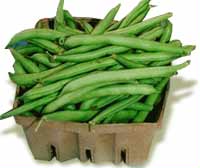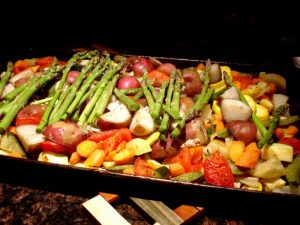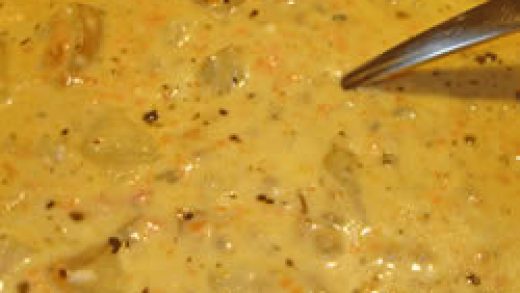Readers of The Bachelor’s Kitchen know we’ve been touting eating less meat and eating more vegetables for some time. Studies repeatedly show Americans don’t eat enough veggies and we eat too much salt, sugar, meat and fat. My doctor keeps trying to get me to eat more beans and greens. I’m trying, but I certainly understand how difficult it can be to make dietary changes. Now, I’m not talking about diets here, I’m talking about regular eating habits for the long term. In fact, making short term changes to lose weight don’t work unless they turn into long term changes.
Summer is coming, and that means there will be lots of vegetables in the local farmers markets. I strongly urge you to do more of your shopping at these places. Yes, sometimes things are more expensive. But the difference in quality is amazing. Also, you’re helping small businesses and local farmers make a living. That’s a very good thing.
One challenge for cooks is to come up with new ways to prepare foods. We tend to fall back on tried and true methods, often relying on the way we ate when we were growing up. We grill steaks, braise roasts, steam vegetables, boil starches, fry fish and bake chicken. But vegetables can be very versatile. They can open a whole new world you never thought of.
Here are a few ideas you may not have thought of. Give some of these a try and see if it brings a whole new palette to your culinary art.
Trimmings have flavor. We’ve discussed before the idea of taking the trimmings from your vegetables and use them to make a flavorful stock. It can be surprising just how much flavor can be wrung from the things we otherwise throw away.
- Have you ever touched the stem of a tomato plant and then smelled tomatoes on your hands for hours?
 Those stems are where so much of the tomato aroma comes from. And we know smells are just as important to taste as other components. Take the stems you trim from tomatoes and use them as a flavoring in sauces and stocks.
Those stems are where so much of the tomato aroma comes from. And we know smells are just as important to taste as other components. Take the stems you trim from tomatoes and use them as a flavoring in sauces and stocks. - Celery leaves from the top of the stalks not only add a lot of flavor to stock, but can be used in a salad. They have an intense celery flavor.
Speaking of salads, that’s a great way to get the benefits of both cooked and raw vegetables.
- Cheap, dried mushrooms can really elevate that salad to meaty extravagance without adding fat.
- Greens that would usually be cooked for a long time, like kale, can be made more palatable raw by chopping them into small pieces.
- And while you’re at it, dump that bottled dressing and start making your own using good extra virgin olive oil, citrus juice, wine vinegar and plain yogurt instead of mayonnaise. You’ll find it fun to come up with your very own exclusive dressing recipe. Kind of like playing Mad Scientist.
Spice it up. Go beyond salt and pepper to the exotic world of spices from around the globe. There’s a reason European empires spent a lot of time, money and lives to bring home spices from the East. Indian cooking is especially adept at using many flavors not commonly found in much of our cooking on this side of the planet. Take the time to visit a spice shop and ask the clerk to show you something different that you might not have tried.
Get fruity. Fruit juice, chopped dried fruit and zests can add a whole new dimension to savory dishes where you might not think of using fruit. A little acid and a little sweetness can bring out flavors as a finishing touch to lots of dishes, including vegetables.
Roast ’em. Almost all vegetables can be roasted. It’s an easy, flavorful way to cook them. Start by chopping your cleaned veggies into just over bite-size pieces. Toss with salt, pepper, olive oil, balsamic vinegar, dried herbs and a blend of spices. Old Bay Seasoning can be used for more than just boiling seafood. A little anchovy paste packs a lot of flavor without being fishy. Spread the coated veggies onto a baking sheet and bake at 400º for 30 to 40 minutes until they are just tender. You’ll probably want to turn them and mix them up about halfway through.
Bean it. Beans are showing up more and more as the new miracle vegetable. They are packed with nutrients and can be used in many different ways.
- Hummus can be made from more than just garbanzo beans or chickpeas. Cooked lentils, black beans or blackeyed peas can be pureed the same way with olive oil, garlic and lemon juice to make a whole new dip for vegetables or chips.
- Beans are easy to cook, especially if you have a slow cooker. Just put them in a pot with enough water to cover and a chunk of starchy tuber like a potato. Add in spices, but no salt, a quartered onion and maybe some celery chunks and let it go for the rest of the day. Taste the broth at the end and then add salt. Don’t throw that creamy, flavorful liquid away. You can, however, throw away those chunks of potato, onion or celery as they’ve given all they have to the beans. Beans can be added cold to salads, mixed with other vegetables like corn, broccoli or cauliflower, or thickened up, spiced up and served over rice for a tasty main or side dish.
- When using canned beans, always rinse thoroughly. Yes, even chili beans that come immersed in spicy gravy. Make your own spicy gravy when you use them in your dish.
- Go beyond green beans. There are many different kinds out there. Don’t be afraid to explore. Most beans are cooked the same way, so you can apply your best Hoppin’ John recipe to a pot of black or cannelloni beans.
- Add cooked beans to any soup, stew, casserole or stir-fry to bump up both the flavor and nutrition.
As you can see, what you can do with vegetables is limited only by your imagination and desire to explore other possibilities. Be daring. Get creative in your Bachelor’s Kitchen.





